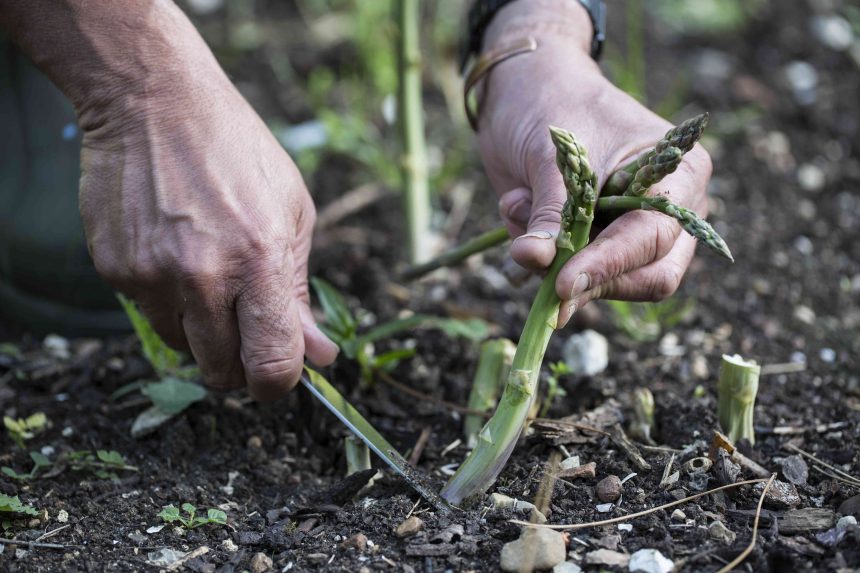Prized for their edible stems, or spears, asparagus plants are one of the few vegetables that grow perennially, and they’re harvested in spring—long before other crops have even sprouted. But while most gardeners grow green, white, or purple asparagus from year-old transplants or “crowns,” you can save money and make your garden more self-sufficient by growing asparagus from seed instead.
In this guide, we’ll walk you through the basics of when and how to plant asparagus seeds and teach you how to transplant, care for, and harvest your own asparagus.
When and Where to Plant Asparagus Seeds
Ekaterina Toropova / Getty Images
The main difference between growing asparagus from seeds versus asparagus crowns is that you’ll need to wait an extra year to harvest asparagus grown from seed. But the good news is that asparagus seeds are easy to grow, and they can be started indoors or directly in the garden.
Asparagus seeds are usually started inside pots or trays in early spring—about 10 to 12 weeks before the last frost. However, asparagus seeds can also be directly sown in in-ground or raised bed gardens after the final frost of spring.
Want more gardening tips? Sign up for our free gardening newsletter for our best-growing tips, troubleshooting hacks, and more!
How to Plant Asparagus Seeds
Many growers keep asparagus plants in nursery beds for the first year of growth to avoid weed competition and provide young plants with the right conditions for sturdy root development. Whether you’re planning to start asparagus seeds indoors or out, here’s how to create a simple nursery bed and sow asparagus seeds.
Preparing the Nursery Bed
Toni Jardon / Getty Images
To start, choose a growing location that receives at least seven hours of direct sun daily and follow these tips to create a nursery bed.
- Loosen the soil to a depth of 10 to 12 inches and remove any rocks and weeds.
- Test the soil and add soil amendments (if needed). Asparagus grows best in rich, well-draining soil with a pH between 6.5 and 7.0.
- Before planting asparagus seeds or transplants, mix several inches of compost or aged manure into the top few inches of soil.
Indoor Sowing
Planting asparagus seeds indoors in early spring takes a bit more time, but it gives you more control over the growing conditions and health of young seedlings.
- Soak the seeds in water for a few hours before planting. While the seeds are soaking, fill seed starting trays or pots with pre-moistened seed starting mix.
- Sow one to two asparagus seeds per pot or seedling cell, cover the seeds with ½-inch of seed starting mix, and add a humidity dome.
- Place the seedlings under a grow light and on top of the seedling heating mat and set to 75 to 85 degrees Fahrenheit. Water regularly until the seeds sprout. This can take a few weeks, so be patient!
- Once the seedlings germinate, remove the humidity dome and heating mat. Continue to water regularly to keep the soil moist, but not soggy.
- When the seedlings are a few inches tall, leave one seedling per pot or seedling cell and thin out the rest.
- Transplant indoor seedlings outside when they’re a few inches tall and the danger of frost has past.
Outdoor Sowing
The Spruce / Karoki David
For a more hands-off approach, plant asparagus seeds outdoors in prepared nursery beds after the last spring frost.
- Plant seeds ½-inch deep, and 2 to 3 inches apart, in rows spaced approximately 1 foot from each other. If possible, soak the asparagus seeds in water before planting to speed up germination.
- Water often to keep the soil moist and weed regularly to prevent weed competition. Asparagus seeds should germinate in a few weeks.
- Once the seedlings have sprouted and are a few inches tall, spread a light layer of straw mulch around the soil line to block out weeds.
Transplanting Seeds
Helin Loik-Tomson / Getty Images
Seedlings started outdoors won’t need to be transplanted during their first year of growth. However, indoor seedlings should be transplanted outside after the last frost date of spring.
- Harden the seedlings off over one to two weeks by moving the seedlings outdoors during the day and indoors at night. Gradually increase the amount of time the seedlings are outside and the amount of sun they’re exposed to until the plants can handle full sun.
- Transplant the asparagus seedlings into rows spaced about 1 foot apart in a prepared nursery bed. Space each plant about 1 foot from its neighbor and bury the seedlings deep enough to cover their roots.
- Water well and apply a light layer of straw mulch.
How to Care for Asparagus
After growing for one year in the nursery bed, asparagus crowns can be transplanted into your main garden in early spring. Before planting, loosen the soil and add amendments, then plant the year-old asparagus crowns in 6-inch deep trenches spaced 2 to 3 feet apart. Fan the plants’ roots out, space individual plants 2 feet from each other, cover the roots with 2 inches of soil and follow these quick-care tips to maintain a healthy asparagus crop.
- Mounding. Every few weeks, add more soil over the asparagus crowns until the crowns are covered with a small mound of earth. In winter, layer 4 to 6 inches of straw mulch over the roots for insulation.
- Watering. Provide asparagus plants with about 1 inch of water per week.
- Fertilizing. Fertilize asparagus once or twice a year in early spring, and after harvest, with a well-balanced fertilizer or compost.
- Weeding. Asparagus doesn’t compete well with weeds and beds need regular weeding.
- Pruning. Don’t cut the fern-like leaves from asparagus plants until they die back in the fall. Those leaves fuel next year’s growth of asparagus.
Harvesting Asparagus
If you start asparagus plants from seed, you’ll need to wait at least three years to harvest edible spears. Asparagus season begins in spring and stretches until the end of June, but you should only harvest spears for two to three weeks during the first harvest season. Harvest spears when they’re as wide as your finger and about 6 to 8 inches long, and use a sharp knife to cut the spears off at the soil line to limit plant damage.
FAQ
-
It takes three years to grow asparagus from seed to harvest.
-
Yes, you can directly plant asparagus seeds in the ground after the last frost of spring.
-
Growing asparagus from seed is more budget-friendly, but it takes one year longer than growing asparagus from crowns.
-
No, you should not harvest first year asparagus. Harvesting asparagus prematurely can drain your plants of energy and reduce harvest yields.








